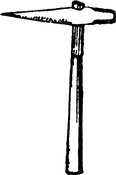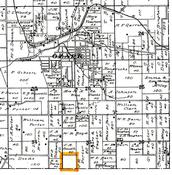Alma, Mo.
 Springfield Daily Leader, November 5, 1923
Springfield Daily Leader, November 5, 1923
"Plat of former mining town found in a bank at Ozark.
Town of 'Alma' once promised to be flourishing lead mining center but ore bearing veins 'pinched out' and camp disappeared.
'While sorting through some files of papers in the archives of the Bank of Ozark, cashier Charles Y. Walker found a town plat that has an interesting history. It is the plat of the once flourishing mining town 'Alma' which was located on the tract of land described on the plat as ‘southwest quarter of the southwest quarter of section 35, township 27, range 21’. The plat was made by Innes & Innes, ‘civil engineers, surveyors and architects’ of Springfield. It is on a sheet of paper 17 x 18 ½ inches in size, which is in a fair state of preservation and only slightly torn. It bears the date September 27, 1876. The plat shows 16 town blocks, 10 of them laid off in business lots and there are four blocks of ‘reservations’. The streets were named Main, Onstott, Williams and Massey streets running north and south and those running east and west were called avenues and were named Miller, Howard and Harrison avenues.
"David Wolf and Dan Weaver are thought to have been the first to discover lead ore in the vicinity, their first find being in 1874 and the discovery very naturally created much excitement, those who owned land thereabout or who secured ‘mining claim’ thinking they were destined to become wealthy, and new people flocked to the scene rapidly.
"J.C. Rogers was county assessor in Christian County in 1877 and 1878 and assessed the property of the town which was then a promising mining settlement or camp and may have had as many as 500 inhabitants. All of the buildings were small frame structures and there were many tents but there were several stores, the leading merchant being William H. H. Miller. Oscar DeGraff was also prominent in the business of the town and the mining industry. There were a number of mining shafts and three smelters from which considerable quantities of lead ore were produced and Mr. Rogers says they hauled the ore in wagons to Ozark and other points and sold it at the rate of $9 per thousand. Lead now sells for about $110 per thousand.
"Thomas L. Robertson also remembers about his father Captain J. R. Robertson and A. T. Yoachum who were then in business in the ‘big brick’ as it was then called (the small two story brick building on the south side of the square in Ozark, which was then the only brick store building in the county) buying ores from the miners and ‘grub staking’ them to try their luck. It was during this mining period that Tom [Robertson] returned from St. Louis, where he had for some time been studying the dry goods business and working in a wholesale house and with the money he had saved bought the interest of Mr. Yoachum in the store. Newt Howell also remembers Alma, having lived there and worked in the mines and otherwise.
"Mr. Rogers and Mr. Howell both tell that Essau Smith, father of Marion Smith of Ozark, owned a tract adjoining the town on which they found an apparently rich deposit of lead ore and that Alex Kissie of Taney County offered to trade a fine farm of 160 acres and a good team of mules and perhaps other property for his mining tract which was 150 feet square but Smith refused the offer. The Smiths worked the mine for some months getting only moderate returns and the supply of mineral ‘pinched out’.
"The town flourished for possibly three years and then as the supply of lead failed and the returns did not justify working, the people moved away, most of them going to Joplin, which was just then beginning to open lead and zinc mines and within a few years the once promising ‘Alma’ had disappeared.
"The land passed into the hands of Mr. Rogers, who secured from the county court an order vacating the streets and alleys and reservations and he sold the 40 acres to Gilbert for $10 an acre. It passed through several changes of ownership and finally about four years ago became part of the farm of W. R. Bain, who bought it from John R. Porter at $100 an acre.
"The name ‘Alma’ was given to the town in honor of the daughter of Mr. and Mrs. John Onstott. On the back of the sheet of paper is the certificate of the filing of the plat by John Onstott and his wife, Vada Elizabeth and the certificate of O. H. Barker, a notary public of Greene County."
 This image is from the 19 Christian County Plat Book. Alma was located in the area outlined in orange. No owner is listed. There were towns called Alma in Wright, Webster and Lafayette Counties according to Moser's Directory of Towns, Villages and Hamlets. There is also a short reference to Alma in Ozarks/Ozarks: Establishing a Regional Term by Lynn Morrow and Ozark and Vicinity in the Nineteenth Century by William Neville Collier.
This image is from the 19 Christian County Plat Book. Alma was located in the area outlined in orange. No owner is listed. There were towns called Alma in Wright, Webster and Lafayette Counties according to Moser's Directory of Towns, Villages and Hamlets. There is also a short reference to Alma in Ozarks/Ozarks: Establishing a Regional Term by Lynn Morrow and Ozark and Vicinity in the Nineteenth Century by William Neville Collier.
Find this article at http://thelibrary.org/blogs/article.cfm?aid=1539&lid=0